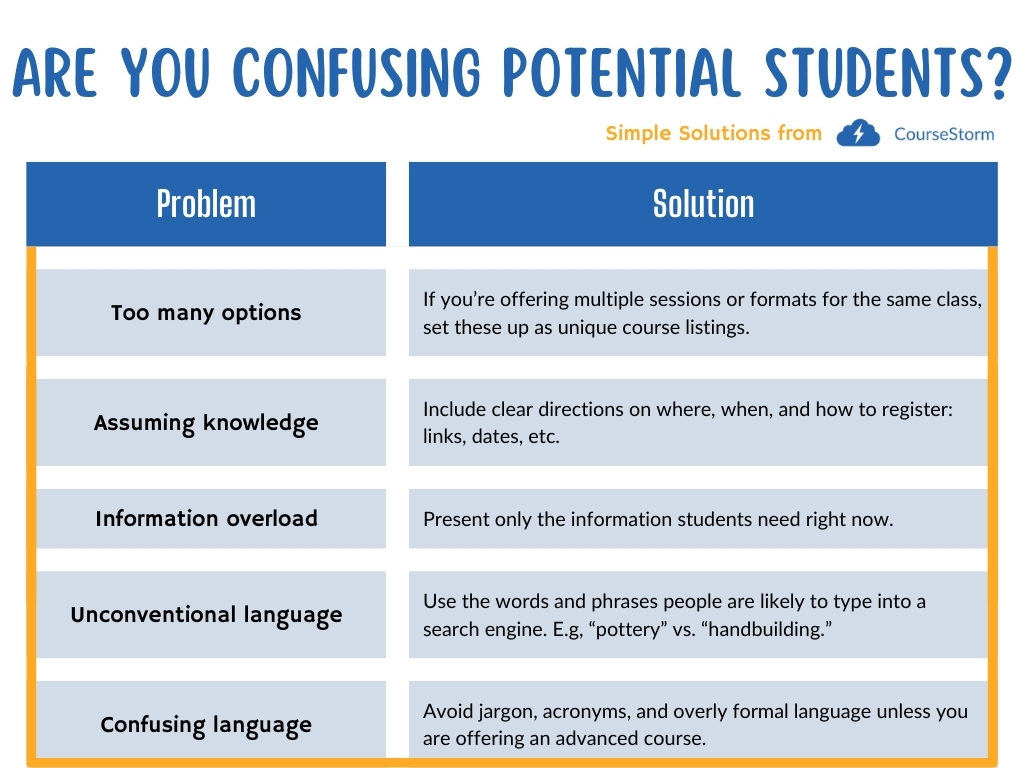Are You Confusing Your Customers? How to Craft Clearer Marketing Messages



Jargon, buzzwords, industry speak — whatever you call it, most organizations have an internal language that doesn’t make sense to outsiders. That’s fine in a board meeting, but it can lead to confused customers when you’re marketing your classes.
Even the most down-to-earth organization can evolve its own language over time. What sounds like a perfectly clear offer to you can end up confusing your potential students. That’s a problem because people don’t buy what they can’t understand.
As part of our commitment to simplicity, we want to help you clarify your message. Let’s talk about how to notice when your message is confusing, and what you can do to fix it.
How to Tell if Customers Are Confused
Most organizations could benefit from making their messaging clearer. Unfortunately, it can be hard to tell that a message isn’t as clear as you thought. After all, you know what you mean. Keep an eye out for these four signals that you might have a messaging problem.
- People don’t seem to understand your offer.
- You hear the same questions over and over.
- Registration is low overall (or for a specific class).
- You get no response from a normally engaged audience.
Any of these four situations can point to a messaging problem. Stay alert for these signals, because most customers won’t reach out and say, “Hey, I didn’t understand your last email at all.” They’ll just ignore it.
Clearer messaging in your course marketing can lead to more engagement, fewer questions, and higher registration numbers.
It’s up to you to notice that there’s a potential problem. Then you can test and see if clearer messaging leads to more engagement, fewer questions, and higher registration numbers. Before we get into how to do that, let’s consider some common sources of customer confusion.
Common Sources of Customer Confusion
Any email, social media post, or class listing you publish has the potential to cause confusion. Everyone has their own perspective and context. So what’s perfectly clear to you might be as muddy as old paintbrush water to your students. Here are a few circumstances that often result in confused customers.
Offering too many options in a single class listing or email.
You might think that offering lots of choices is the best way to meet student needs. In reality, too many choices can be overwhelming. If you’re offering multiple sessions or formats for the same class, set these up as unique course listings.
Assuming knowledge of your registration system or process.
You’ve been using the same system or process for a while, so you assume that everyone knows how to use it. Keep in mind that someone might have just discovered your program for the first time, and they won’t know anything about how it works. So you have to tell them. Include clear directions on where and how to register.
Offering too many options, assuming people know how to register, and using unfamiliar jargon or language are all common sources of customer confusion.
Sharing non-essential details in the class listing.
You don’t want to assume knowledge, but you also don’t want to bombard students with too much information. Think about which information they need to know up front, and what can wait until the first class. For example, the time and location of your class are essential, but you can wait until the first day to tell them that they’ll need to bring a photo of themselves to the third session.
Using unconventional language in headings and descriptions.
You may have strong opinions about how your industry should work. Sometimes that is reflected in the language you use. You might think that we should stop talking about “art” and start exploring creative play, but parents looking for an art class for their child may skip right past your listing for a creative play class because they don’t immediately understand what it means.
Besides, using common words and phrases helps people discover your classes. Try to use the words and phrases people are most likely to type into a search engine when looking for classes like yours.
Using confusing language anywhere.
Jargon, acronyms, and overly formal language can confuse potential registrants. The word “dramaturgy” may be correct, but inviting students to a “playwriting” class is more straightforward. Unless you’re offering an advanced course, keep the language simple and accessible.

How to Fix Your Messaging Problem
If you suspect you have a messaging problem, take action. The longer you delay, the more students are likely to miss out on your classes. Here’s a four-step process to help.
Step 1: Identify the source of the confusion using the list above.
Step 2: Rewrite or redesign your message for clarity.
Step 3: Talk to students and ask for feedback on the changes.
Step 4: Monitor your results.
The best way to tell if your changes worked is to track the number of questions and registrations you receive. If questions decrease and registrations increase, you’ve probably made your message clearer.
"We've increased enrollments and eliminated nearly all the phone calls we used to receive from confused parents.” – a CourseStorm customer
By using CourseStorm, Princeton Academy of Art has reduced the time they previously spent managing enrollment by 80% and increased enrollments in their classes. In addition, “We’ve eliminated nearly all the phone calls we used to receive from confused parents,” they shared.
One Last Tip to Eliminate Customer Confusion
A convoluted registration process can confuse customers as quickly as poor messaging. CourseStorm’s integrated online registration and payment platform keeps registration simple. Registrants can easily fill out your registration form, pay for the class, and even get class meeting reminders all on one simple platform.
To see how easy it is, connect with the CourseStorm team for a free demo today.





